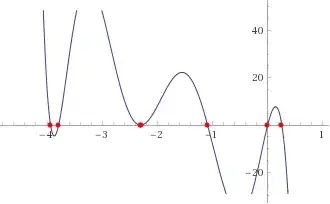Let $P_{28}(x)$ is the issue polynomial and
$$R(x) = x^{-14}P_{28}(x).$$
Then
$$C(t) = R(e^{it}\sqrt2) = 4(64\cos14t+288\cos12t+624\cos10t$$
$$+760\cos8t+304\cos6t-768\cos4t-1928\cos2t-1217),$$
and
$$P_7(y) = C\left(\dfrac12\arccos\dfrac y4\right) = y^7+9y^6+11y^5-121y^4-480y^3-608y^2-168y+92.$$
Another way is using of the Chebyshev Polynomials of the First Kind, then
$$P_7(y) = 4(64T_7\left(\dfrac y4\right) + 288T_6\left(\dfrac y4\right) + 624T_5\left(\dfrac y4\right) + 760T_4\left(\dfrac y4\right)$$
$$ + 304T_3\left(\dfrac y4\right) - 768T_2\left(\dfrac y4\right) - 1928 \dfrac y4 - 1217),$$
with the same result (idea of OP author, see the comments).
Easily to show that $P_7(y)$ has only one root out of the interval $(-4,4)$ (proposition of the OP author, see the comments).
Since
$$P'_7(t+4) = 7t^6 + 222t^5 + 2815t^4 + 17996t^3 + 59472t^2 + 90240t + 39000$$
and
$$P_7(4) = -29968 <0,$$
then $P_7(y)$ has a single root on the interval $(4,\infty).$
On the other hand,
$$P'_7(-4-t) = 7 t^6 + 114 t^5 + 655 t^4 + 1684 t^3 + 1968 t^2 + 896 t + 88$$
and
$$P_7(-4) = 16 >0,$$
so there are not roots in the interval $(-\infty,-4).$
At the same time, the plot of $P_7(7)$

shows that there are six different roots in the interval $(-4,1),$ which can be easily separated.
Approximately, the roots are
$$y_k\in\{4.16023,0.25701,-1.08886,-2.29038,-2.31414,-3.78887,-3.93500\}.\tag1$$
Since
$$y=4\cos2t,\quad t = -i\ln\dfrac x{\sqrt2},$$
then
$$y=4\cos\left(-2i\ln\dfrac x{\sqrt2}\right) = 2\left(e^{\large2\ln\frac x{\sqrt2}} + e^{-\large2\ln\frac x{\sqrt2}}\right) = x^2 + \dfrac4{x^2},$$
$$y-y_k = x^2-4\dfrac {y_k}4 + \dfrac4{x^2},$$
$$P_{28}(x) = \prod\limits_{k=0}^6\left(x^4-4\dfrac{y_k}4 x^2+4\right),\tag2$$
wherein
$$y_0 > 4,\quad |y_{1-6}| <4.$$
Therefore, required decomposition of $P_{28}(x)$ is confirmed.
